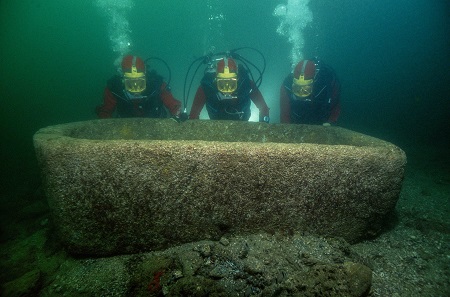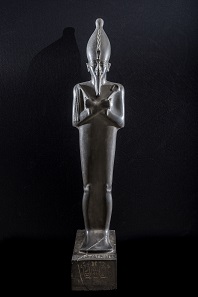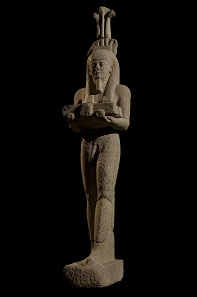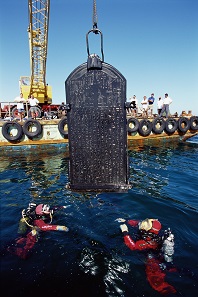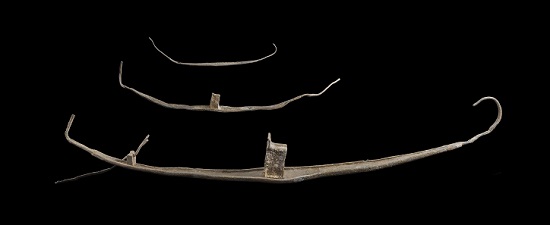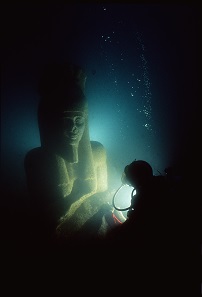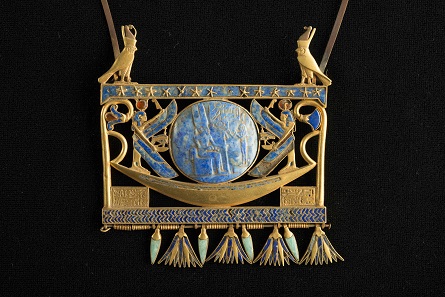July 7, 2016 – The BP exhibition ‘Sunken cities: Egypt’s lost worlds’ is the British Museum’s first large-scale exhibition of underwater archaeological discoveries and has opened for an extended six-month run through 27 November 2016.
Map of the Nile Delta.
Telling the story of two lost Egyptian cities and their recent rediscovery beneath the Mediterranean seabed, it shows how the exploration of Thonis-Heracleion and Canopus – submerged at the mouth of the River Nile for over a thousand years – is transforming our understanding of the relationship between ancient Egypt and the Greek world.
“Garden vat”. Pink granite. L. 205 cm. Ptolemaic Period, IVth-IInd century BC. Thonis-Heracleion, Aboukir Bay (SCA 459). © Franck Goddio / Hilti Foundation – Photo: Christoph Gerigk.
300 outstanding objects have been brought together including more than 200 spectacular finds excavated off the coast of Egypt near Alexandria between 1996 and 2012. Important loans from Egyptian museums rarely seen before outside Egypt (and the first such loans since the Egyptian revolution) are complemented by objects from various sites across the Delta drawn from the British Museum’s collection; most notably from Naukratis – a sister harbour town to Thonis-Heracleion and the first Greek settlement in Egypt.
The ruins of antique Canopus were located at some 2km east of the western fringe of the Nile delta, in Aboukir Bay. © Franck Goddio / Hilti Foundation – Photo: Christoph Gerigk.
Likely founded during the 7th century BC, Thonis-Heracleion and Canopus were busy, cosmopolitan cities that once sat on adjacent islands at the edge of the fertile lands of the Egyptian Delta, intersected by canals. After Alexander the Great’s conquest of Egypt in 332 BC, centuries of Greek (Ptolemaic) rule followed.
Statue of Osiris, Egyptian Museum Cairo (JE30997, CGC 38231). Grey-green Graywacke, H. 1.50 m. © Franck Goddio / Hilti Foundation – Photo: Christoph Gerigk.
The exhibition reveals how cross-cultural exchange and religion flourished, particularly the worship of the Egyptian god of the afterlife, Osiris. A statue of Osiris was from the Egyptian Museum in Cairo is also on display. This masterpiece of Saite statuary carries a dedication from the “divine adorer of Amun” Nitocris, daughter of Psamtik I (664-610 BC).The look of the “Lord of Life” seems fixed on a point beyond space and time, and his entire being radiates an intense energy of life.
By the 8th century AD, the sea had reclaimed the cities and they lay hidden several metres beneath the seabed, their location and condition unclear. Although well-known from Egyptian decrees and Greek mythology and historians, past attempts to locate them were either fruitless or very partial. The exhibition shows how a pioneering European team led by Franck Goddio in collaboration with the Egyptian Ministry of Antiquities made use of the most up-to-date technologies to find them.
Thanks to the underwater setting, a vast number of objects of great archaeological significance have been astonishingly well preserved.
Pristine monumental statues, fine metalware and gold jewellery reveal how Greece and Egypt interacted in the late first millennium BC. These artefacts offer a new insight into the quality and unique character of the art of this period and show how the Greek kings and queens who ruled Egypt for 300 years adopted and adapted Egyptian beliefs and rituals to legitimise their reign.
The exhibition features a number of extraordinary, monumental sculptures – some of the largest objects ever to come to the Museum on loan.
Colossal statue of god Hapy of red granite (5.4 m) once decorated the temple of Thonis-Heracleion, Aboukir Bay, Egypt (SCA 281). Early Ptolemaic period, 4th century BC. © Franck Goddio / Hilti Foundation – Photo: Christoph Gerigk.
A 5.4m, 6-tonne statue of Hapy, a divine personification of the Nile’s flood, greets visitors as they enter the space. The god of the flooding of the Nile, symbol of abundance and fertility, has never before been discovered at such a large scale, which points to his importance for the Canopic region: height 5.4 metres, depth 90 centimetres, weight 6 tonnes.
Later, two further colossal statues are revealed – a King and his Queen – an unusually well preserved depiction of a Ptolemaic ruling couple.
Apis Bull, Greco-Roman Museum, Alexandria (GRM 351). © Franck Goddio / Hilti Foundation – Photo: Christoph Gerigk.
Masterpieces from Egyptian museums such as the Apis bull from the Serapeum in Alexandria are shown alongside magnificent recent finds from the sea. The magnificent statue of the bull god Apis presented naturalistically (H. 190 cm), dating back to Emperor Hadrian’s reign, had been discovered at the entrance to the underground galleries of the Serapeion of Alexandria.
Statue of Arsinoe, Canopus, Aboukir Bay, Egypt (SCA 208). © Franck Goddio / Hilti Foundation – Photo: Christoph Gerigk.
One such piece is the stunning sculpture from Canopus representing Arsinoe II (the eldest daughter of Ptolemy I, founder of the Ptolemaic dynasty). The Greco-Macedonian queen became a goddess beloved to both Egyptians and Greeks after her death and is depicted here as the perfect embodiment of Aphrodite, a goddess of beauty ‘who grants fortunate sailing’. Cut in hard, dark stone, this feminine body has a startlingly sculptural quality. Complete, it must have been slightly larger than life-size. The statue is certainly one of the queens of the Ptolemaic dynasty (likely Arsinoe II) dressed as the goddess Isis, as confirmed by the knot that joins the ends of the shawl the woman wears, which was representative of the queens during this time period. The statue was found at the site of Canopus.
The exhibition also covers the arrival of Greeks in Egypt, when they were hosts and not rulers; privileged but controlled by the pharaohs.
Stele of Thonis-Heracleion, Thonis-Heracleion, Aboukir Bay, Egypt (SCA 277). © Franck Goddio / Hilti Foundation – Photo: Christoph Gerigk.
A complete stela from Thonis-Heracleion advertises a 380 BC royal decree (‘decree of Sais’) of the Egyptian pharaoh Nectanebo I (378-362 BC). It states that 10% of the taxes collected on all goods imported from the ‘Sea of the Greeks’ into Thonis-Heracleion and on all trade operations at Naukratis were to be donated to an Egyptian temple. The intact stele (1.90 m) was discovered on the site of Thonis-Heracleion. It is almost identical to the Stele of Naukratis in the Egyptian Museum in Cairo. The place where it was to be situated is clearly named: Thonis-Heracleion.
A wide range of objects, from modest to grand and costly, bear witness to the piety of both inhabitants and visitors at these major religious centres.
Votive Barques, Thonis-Heracleion, Aboukir Bay, Egypt (SCA 1606, 1617, 1607, 1591). © Franck Goddio / Hilti Foundation – Photo: Christoph Gerigk.
The archaeologists of the Institut Européen d’Archéologie Sous-Marine (IEASM) discovered numerous votive objects, amongst them leaden votive barques, littering the channels and basins of the port around the temple of Amun-Gereb on the site of Thonis-Heracleion. These lead models of barges uncovered in the sacred waterway linking Thonis-Heracleion to Canopus are unique and moving finds. They are associated with the Mysteries of Osiris, the most popular festival celebrated annually across Egypt during the month of Khoiak (mid-October to mid-November). Ranging in size from 6 to 67cm, these reproduce in metal a flotilla of 34 papyrus barges that would have been displayed on a waterway to celebrate the first sacred navigation of the festival. According to religious texts, each barge was to measure 67.5 cm and to bear the figure of an Egyptian god, and would have been illuminated by 365 lamps. The lead barges are lasting testimonies possibly left by people who, long ago, celebrated this festival in the Canopic region.
The stele of Thonis-Heracleion in situ under water. © Franck Goddio / Hilti Foundation – Photo: Christoph Gerigk.
Only a tiny proportion of these sites have revealed their secrets. The on-going underwater archaeological mission continues to bring to light new masterpieces and further research every year as the most recent finds from 2012 will show.
The exhibition is in five sections, beginning with the story of the cities’ rediscovery in ‘Rediscovering Thonis-Heracleion and Canopus’. It is followed by ‘Egypt and Greece: early encounters’ as people, goods and ideas began to flow between the two countries from around 650 BC; ‘Greek kings and Egyptian gods’ in which the Ptolemaic dynasty and legacy of Alexander the Great is explored; ‘Osiris: from myth to festival’ which shows how extraordinary recent discoveries bring to life the most secretive of ancient religious ceremonies, the Mysteries of Osiris; and finally ‘Egypt and Rome’ which explores how following the capture of Alexandria by Rome in 30BC, aspects of a fused Greek and Egyptian religion were exported across the Roman Empire.
Breathtaking underwater footage and photography is used throughout the exhibition.
Pectoral in gold, lapis lazuli and glass paste, found in Tanis in the royal tomb of the Pharaoh Sheshonk II (c. 890 BC), Egyptian Museum, Cairo JE 72171. © Franck Goddio / Hilti Foundation – Photo: Christoph Gerigk.
Among the spectacular findings is also a jewel that belonged to Sheshonk I (945-925 BC), as indicated by the inscription incised inscription on the left side of the gold plaque below the boat. The pendant represents the solar barque floating on the primeval waters under a star-spangled sky. The sun of lapis-lazuli sun, protected by the spread wings of Isis and Nephtys, is incised, showing the goddess of truth and cosmic order (Maat) adoring Amon-Re.
The display is on show in the Sainsbury Exhibitions Gallery (Room 30). It is supported by BP, organised with Hilti Foundation and the Institut Européen d’Archéologie Sous-Marine in collaboration with the Ministry of Antiquities of the Arab Republic of Egypt.
The beautifully illustrated exhibition catalogue, The BP exhibition ‘Sunken Cities: Egypt’s Lost Worlds’, edited by Franck Goddio and Aurélia Masson-Berghoff, is published by Thames & Hudson in partnership with the British Museum. Hardback £40, paperback £25.
Engaging, informative and full of fun facts for children ‘Secret Treasures of Ancient Egypt: Discover the Sunken Cities’ by Kate Sparrow and illustrated by Esther Aarts is published by Nosy Crow in partnership with the British Museum. Hardback £12.99, paperback £6.99.
The exhibition will be accompanied by a full public programme.
Follow updates on the exhibition via Twitter with #SunkenCities and follow the Museum.
For more information on the display you may visit the British Museum website.






